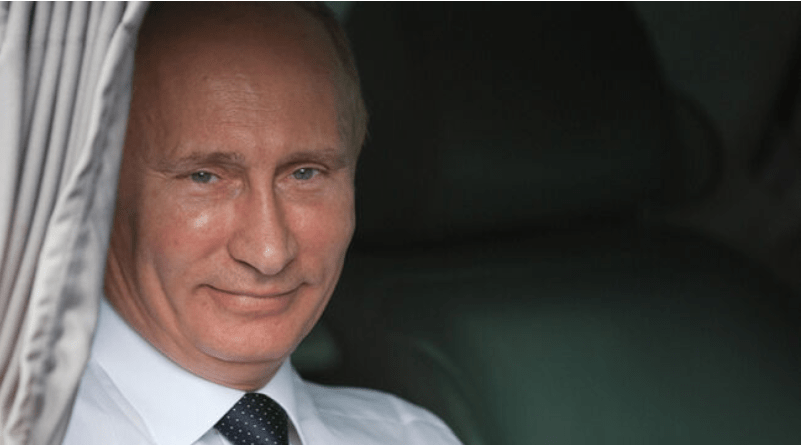Putin Doesn’t Bluff
Guest Post by Jim Rickards

Two weeks ago, the Congress passed (and President Biden signed) four key pieces of legislation related to national security.
Three of the bills provided assistance to Ukraine, Israel and Taiwan. They received the most attention. The one that got the least attention was a mixed bag of provisions, such as a forced divestiture of TikTok.
Included in that bill was something called the REPO Act that authorizes the president to steal any Russian assets, including U.S. Treasury securities, that come under U.S. jurisdiction.
The impact of the REPO Act is limited by the fact that only about $10 billion of Russian sovereign assets are actually under U.S. jurisdiction. Yet the act contemplates that this theft will be a down payment on a much larger theft to be conducted by NATO allies in Europe.
$290 billion of Russian sovereign assets are being held in Europe. The act says that the assets stolen by the U.S. will be contributed to the Common Ukraine Fund.
No doubt, the U.S. will be the most powerful voice in the administration of the $290 billion common fund. The U.S. goal is to use the G7 summit in Apulia, Italy on June 13–15 as a platform for getting the other G7 members to go along with the Common Ukraine Fund and to steal any Russian assets under their jurisdiction.
So these people think that Russia will simply accept this act of theft without retaliating?
“Mirror Imaging”
One of the persistent problems in intelligence analysis is what experts call “mirror imaging.” This is jargon for an analytic flaw in which the analyst assumes that his beliefs and preferences are shared by an adversary. Instead of looking at the adversary as he actually is, the analyst is looking in a mirror while assuming he is looking at the adversary.
This is an extremely dangerous flaw.
You may be rational, but the mullahs who rule Iran are not. You may believe that leaders want economic growth, but Communist Chinese leaders elevate the party over all other considerations including the well-being of their people.
You may assume that Houthi rebels in Yemen want to avoid attacks by the U.S., but they don’t care — they live in caves anyway, so you can’t bomb them into the Stone Age because they’re already there.
Nowhere is this flaw more apparent today than in the U.S. intelligence analysis of Vladimir Putin. In 2008, President Bush said that Ukraine and Georgia should join NATO. A few months later, Putin invaded Georgia, annexed part of its territory and destroyed Georgia’s chances of joining NATO.
Putin Doesn’t Bluff
In 2014, the U.S. backed a coup d’état in Ukraine that deposed a duly elected leader. Three months later, Putin annexed Crimea from Ukraine and made it part of the Russian Federation. In 2021, NATO began formal processes to admit Ukraine as a member.
In February 2022, Russia began a special military operation that’s resulted in 500,000 dead Ukrainian soldiers. Some estimates are even higher. Ukraine’s chances of joining NATO are now zero.
In every case, U.S. analysts did not believe Putin would take the steps he did because they thought it might somehow weaken Putin or Russia. That’s mirror imaging at its worst. The truth is Putin doesn’t bluff. When he says he will do something, he does. When he says he will react to some Western act, the reaction takes place.
Putin said if the West steals Russian assets, Russia will retaliate by seizing billions of dollars of direct foreign investment in Russia owned by major European companies such as Siemens, Total, BP and others.
And sure enough, just days after Biden signed legislation to authorize the theft of Russian assets, a Russian court ordered $440 million be seized from JPMorgan.
The escalation in the asset seizure war has begun. Putin will win in the end. Unfortunately, escalation is also increasing on the geopolitical front. The U.S. and some of its European allies are becoming increasingly desperate about Ukraine’s ability to hold off Russia on the battlefield.
Short on Weapons, Short on Men
The recent $61 billion aid package for Ukraine (about two-thirds of which will go to U.S. defense companies) won’t be nearly enough to reverse the tide. The U.S. and its NATO allies have already given just about all they can afford to give Ukraine without jeopardizing their own security.
The problem isn’t a lack of money but a lack of weapons and ammunition. Before the aid package was approved, critics complained that Ukraine was losing because the U.S. was withholding desperately needed materiel. But that’s not really true.
The Europeans could have simply bought the weapons from the U.S. and delivered them to Ukraine. They didn’t. Why? Because the weapons simply weren’t there. Yes, there will always be a supply of weapons flowing to Ukraine — they’re not going to run out completely.
But Ukraine won’t have nearly enough weapons and ammunition to undertake meaningful offensive operations against the Russians. They’ll just have enough to keep them in the fight, which is the goal of NATO.
Unfortunately for Ukraine, the problems run much deeper than a lack of equipment. They’re also running out of trained manpower. Former commander Valeriy Zaluzhny has suggested Ukraine needs an extra 500,000 troops. But they’re having trouble finding new volunteers. An estimated 650,000 fighting age men have fled Ukraine.
Meanwhile, the Russian army is even larger than it was before the invasion, and Russian industry is churning out weapons and ammunition at astonishing rates.
Will France Cross the (Dnieper) Rubicon?
When you add up Ukraine’s lack of equipment and manpower shortages, you understand why the West is becoming increasingly desperate.
France’s Emmanuel Macron is continuing to say he might send French troops to Ukraine. Just days ago, he reaffirmed that he wouldn’t rule out sending troops if Russia broke through Ukrainian front lines and Ukraine requested it.
Well, it’s only a matter of time until Russia breaks through Ukraine’s remaining primary defenses east of the Dnieper River. Of course Ukraine is going to request French troops since Macron himself made the offer.
Would they be sent to western Ukraine in order to free up Ukrainian soldiers stationed there to go to the front?
Or would they send French troops to the front, thinking that Russia wouldn’t fire on them out of fears of starting a war with France? France is a nuclear power. It has a limited nuclear arsenal (mostly consisting of four ballistic missile submarines).
So France might believe it can deter Russia from advancing.
But Russia has already targeted French “mercenaries” in a missile strike some months back (they were likely Ukrainian and Russian members of the French Foreign Legion). And Russia has warned France that it will attack French soldiers if it sends them to Ukraine.
Remember, Putin doesn’t bluff. But it’s not just France suggesting a willingness to send troops to Ukraine.
Countdown to Nuclear War
I’ve been warning about the dangers of escalation since the U.S. committed itself to Ukraine’s defense. Unfortunately, it’s playing out exactly as I predicted.
On 60 Minutes last night, House Democratic Leader Hakeem Jeffries said, “We can’t let Ukraine fall because if it does, then there’s a significant likelihood that America will have to get into the conflict — not simply with our money, but with our servicewomen and our servicemen.”
Ukraine’s going to fall, one way or the other. It might not be this year or even next year, although those are possibilities. But it will happen.
If Jeffries is correct that the U.S. will commit its military to confront Russia directly, then we’re signing ourselves up for a nuclear war because that’s where military confrontation will ultimately lead.
Every major simulated war game between the U.S. and Russia ends up going nuclear in the end.
Are we really prepared for that?





